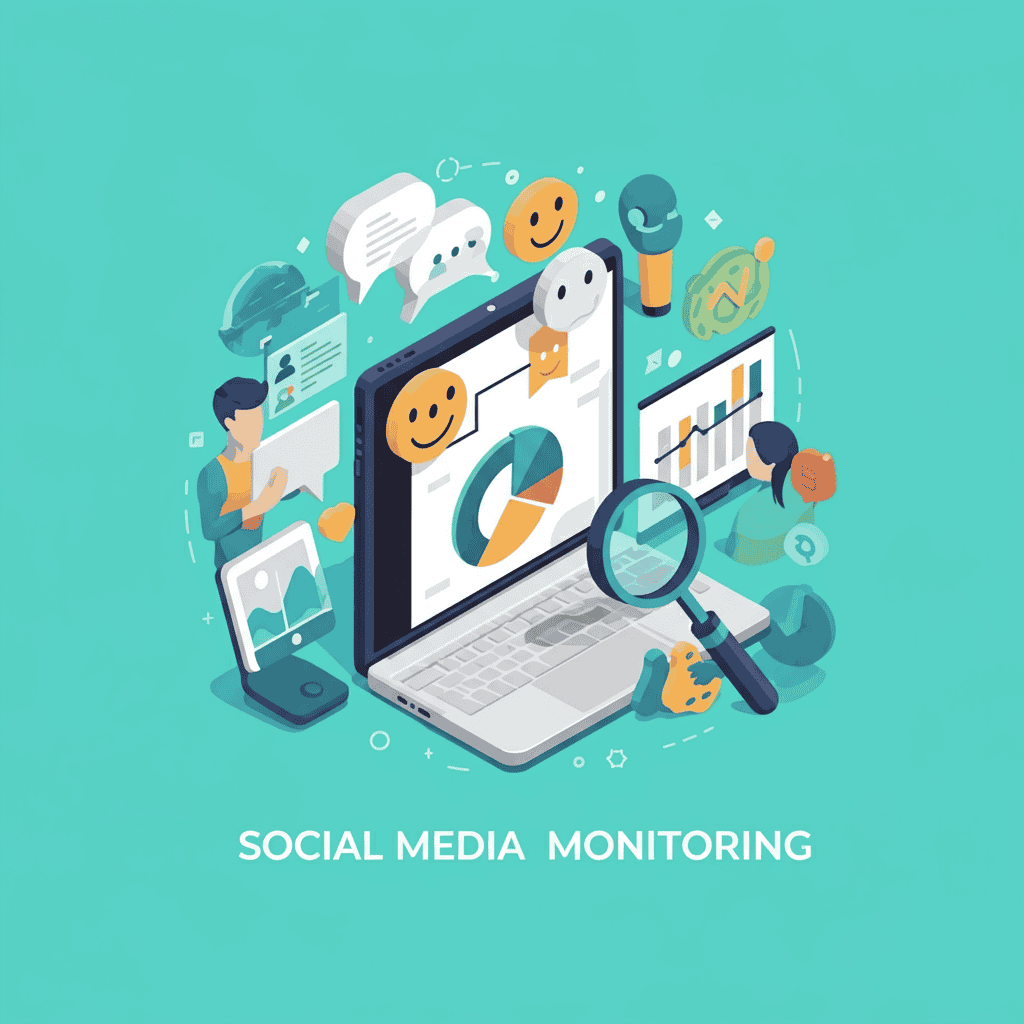Social media monitoring has evolved from a nice-to-have marketing activity into an essential business practice. With over 4.8 billion people actively using social media platforms worldwide, conversations about your brand, industry, and competitors are happening 24/7 across multiple channels. The question isn’t whether these discussions are taking place—it’s whether you’re listening.
This comprehensive guide will walk you through everything you need to know about social media monitoring, from basic concepts to advanced strategies. You’ll discover how to track meaningful conversations, respond to customer feedback effectively, and turn social insights into actionable business intelligence. Whether you’re a small business owner managing your first social media presence or a marketing professional looking to refine your monitoring strategy, this guide provides the tools and knowledge you need to succeed.
Understanding Social Media Monitoring
Social media monitoring is the process of tracking mentions, conversations, and trends related to your brand, competitors, or industry across various social media platforms and online channels. This practice goes beyond simply counting likes and shares—it involves analyzing sentiment, identifying influencers, and extracting actionable insights from social data.
The scope of social media monitoring extends across multiple platforms, including Facebook, Twitter, Instagram, LinkedIn, TikTok, YouTube, Reddit, and various forums and review sites. Modern monitoring tools can track millions of conversations simultaneously, filtering through noise to surface the most relevant and impactful mentions.
Key Components of Effective Monitoring
Brand Mentions: Track direct references to your company name, products, or services, including misspellings and abbreviations that customers commonly use.
Keyword Tracking: Monitor industry-related terms, product categories, and branded hashtags to capture broader conversations that may not directly mention your brand.
Competitor Analysis: Keep tabs on what people are saying about your competitors, their product launches, and customer satisfaction levels.
Sentiment Analysis: Understand the emotional tone behind mentions to gauge public perception and identify potential reputation issues before they escalate.
Social Media Monitoring vs Social Media Listening

While these terms are often used interchangeably, they represent different approaches to social media data. Monitoring focuses on reactive tracking—identifying when your brand is mentioned and responding accordingly. It’s tactical and immediate, designed to catch conversations as they happen.
Social media listening takes a broader, more strategic approach. It analyzes patterns in social data to understand consumer behavior, market trends, and brand positioning over time. Listening helps you understand the “why” behind social conversations, while monitoring helps you manage the “what” and “when.”
Both practices are valuable and complementary. Effective social media strategies incorporate monitoring for day-to-day management and listening for long-term strategic planning.
Why Social Media Monitoring Matters for Your Business
Customer Service Excellence
Modern customers expect brands to be responsive on social media. A study by Sprout Social found that 89% of social messages to brands go ignored, representing a massive opportunity for businesses that actively monitor and respond. Customer feedback monitoring plays a critical role in identifying these messages early, enabling quick, helpful responses that can turn frustrated customers into loyal brand advocates.
Reputation Management
Social media monitoring serves as an early warning system for reputation issues. By catching negative sentiment early, brands can address concerns before they spread and potentially go viral. Proactive reputation management through monitoring helps maintain brand trust and customer loyalty.
Competitive Intelligence
Monitoring your competitors’ social media presence reveals valuable insights about their marketing strategies, product launches, and customer reception. This intelligence helps you identify market gaps, refine your positioning, and stay ahead of industry trends.
Content Strategy Optimization
Understanding what topics and content types generate the most engagement helps refine your content strategy. Monitoring reveals which hashtags perform best, what times your audience is most active, and which content formats drive the highest engagement rates.
Essential Metrics to Track
Volume and Reach Metrics
Mention Volume: Track the total number of times your brand is mentioned across platforms. Spikes in mention volume often indicate viral content, breaking news, or campaign success.
Reach and Impressions: Measure how many people potentially saw mentions of your brand. This helps quantify the scope of your social media presence and campaign effectiveness.
Share of Voice: Compare your brand’s mention volume to competitors within your industry. This metric helps gauge your relative market position and brand awareness levels.
Engagement Quality Metrics
Sentiment Distribution: Analyze the ratio of positive, negative, and neutral mentions. Healthy brands typically see 70-80% positive sentiment, with negative sentiment below 10%.
Response Rate and Time: Track how quickly and consistently you respond to social media mentions. Faster response times correlate with higher customer satisfaction scores.
Engagement Rate: Measure likes, shares, comments, and other interactions relative to your follower count or reach. High engagement rates indicate strong audience connection and content relevance.
Business Impact Metrics
Lead Generation: Track social media mentions that result in website visits, email signups, or other conversion actions. This helps quantify the ROI of your social media monitoring efforts.
Customer Acquisition Cost: Compare the cost of acquiring customers through social media channels versus traditional marketing methods.
Top Social Media Monitoring Tools
Enterprise Solutions
Hootsuite Insights: Offers comprehensive monitoring across multiple platforms with advanced analytics and reporting features. Ideal for large organizations with complex social media needs.
Sprout Social: Combines monitoring with publishing and engagement tools. Strong reporting capabilities and a user-friendly interface make it popular with marketing teams.
Brandwatch: Provides deep analytics and AI-powered insights. Excellent for brands requiring sophisticated sentiment analysis and trend identification.
Mid-Market Options
Buffer: Combines publishing, monitoring, and analytics in an affordable package. Great for growing businesses that need comprehensive social media management.
Socialbakers: Offers competitive benchmarking and audience insights alongside standard monitoring features. Strong AI capabilities for content optimization.
Budget-Friendly Tools
Google Alerts: A Free tool that monitors web mentions of your brand. Limited to Google search results, but useful for basic brand monitoring.
Mention: Affordable monitoring solution with real-time alerts and basic sentiment analysis. Good starting point for small businesses.
Setting Up Your Monitoring Strategy
Define Your Objectives
Start by clarifying what you want to achieve with social media monitoring. Common objectives include improving customer service response times, tracking campaign performance, monitoring brand reputation, or gathering competitive intelligence. Clear objectives help determine which metrics to prioritize and which tools to use.
Identify Keywords and Phrases
Create a comprehensive list of terms to monitor, including your brand name, product names, executive names, branded hashtags, and common misspellings. Include industry keywords and competitor names to capture broader market conversations.
Choose the Right Platforms
Focus your monitoring efforts on platforms where your target audience is most active. B2B companies might prioritize LinkedIn and Twitter, while consumer brands might focus on Instagram and TikTok. Don’t spread your efforts too thin—it’s better to monitor fewer platforms thoroughly than many platforms superficially.
Establish Response Protocols
Create clear guidelines for when and how to respond to different types of mentions. Define response time goals, escalation procedures for negative feedback, and approval processes for sensitive situations. Having protocols in place ensures consistent, appropriate responses across your team.
Best Practices for Effective Monitoring
Respond Promptly and Authentically
Speed matters on social media, but authenticity matters more. Aim to respond to customer inquiries within a few hours, but take time to craft thoughtful, helpful responses rather than rushing to meet arbitrary time targets.
Focus on Quality Over Quantity
Don’t feel obligated to respond to every mention. Focus on interactions that provide value to the customer and your broader audience. Strategic silence is sometimes more effective than unnecessary engagement.
Use Social Listening for Strategic Insights
Look beyond individual mentions to identify broader patterns and trends. Use social listening insights to inform product development, marketing strategies, and customer experience improvements.
Monitor Beyond Your Own Channels
Track mentions across the entire social web, not just your owned channels. Many important conversations about your brand happen on platforms where you don’t have an official presence.
Common Mistakes to Avoid
Monitoring Without Acting
Collecting social media data without taking action based on insights is a wasted opportunity. Ensure your monitoring efforts connect to specific business processes and decision-making frameworks.
Focusing Only on Volume Metrics
High mention volumes don’t necessarily indicate success. A smaller number of high-quality, positive mentions from influential users often provides more value than large volumes of neutral mentions.
Neglecting Internal Stakeholders
Share monitoring insights with relevant teams across your organization. Customer service teams need feedback trends, product teams benefit from feature requests, and executives need reputation updates.
Over-Responding to Negative Feedback
Not every negative mention requires a public response. Sometimes direct messages or offline conversations are more appropriate. Avoid creating larger issues by over-responding to minor complaints.
Maximizing Your Social Media Monitoring ROI
Social media monitoring delivers the greatest value when it becomes an integrated part of your business operations rather than a standalone marketing activity. The most successful organizations use monitoring insights to inform customer service improvements, product development decisions, and strategic planning processes.
Start with clear objectives and gradually expand your monitoring scope as you develop expertise and see results. Focus on actionable insights rather than vanity metrics, and ensure your monitoring efforts connect to measurable business outcomes.
Regular evaluation and refinement of your monitoring strategy ensures continued effectiveness as social media platforms evolve and your business needs change. The brands that succeed with social media monitoring are those that view it as an ongoing investment in customer relationships and market intelligence rather than a one-time setup project.
Learn more: How Customer Feedback Builds Unshakeable Trust





